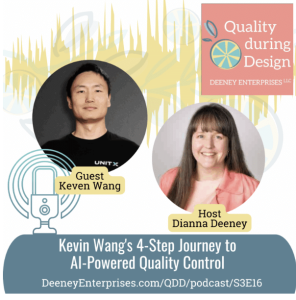
Keven Wang’s 4-Step Journey to AI-Powered Quality Control (A Chat with Cross-Functional Experts)
 Dianna Deeney interviews Keven Wang from UnitX. Keven shared valuable insights about how AI-powered quality control is revolutionizing factories worldwide, beyond inspection. With over 160 customers benefiting from this technology, Wang’s expertise offers a glimpse into both the present capabilities and future potential of AI in manufacturing.
Dianna Deeney interviews Keven Wang from UnitX. Keven shared valuable insights about how AI-powered quality control is revolutionizing factories worldwide, beyond inspection. With over 160 customers benefiting from this technology, Wang’s expertise offers a glimpse into both the present capabilities and future potential of AI in manufacturing.
This interview is part of our series, “A Chat with Cross Functional Experts”. Our focus is speaking with people that are typically part of a cross-functional team within engineering projects.
About Keven
Keven Wang is the Co-Founder & CEO of UnitX, a leading AI Robotics company automating visual inspection in factories. Keven graduated from Stanford University with a degree in Computer Science concentrating on AI. He has visited 135+ manufactures worldwide helping to improve yield and quality, and holds patents in AI
technology for visual inspection.
Keven and Dianna talk about
- Best time to implement AI-powered quality control
- What it takes to train AI
- Best practices in validating new vision systems
- Keven’s 4-step journey to AI manufacturing
- Real success stories
Perhaps most surprising is Kevin’s observation that the greatest challenge in AI adoption isn’t technical but human—aligning teams, establishing shared goals, and helping personnel become comfortable with the technology. This insight underscores that successful implementation requires thoughtful change management alongside technical expertise.
Where AI-powered visual inspection shines
AI-powered visual inspection represents a significant leap forward from traditional inspection methods. As Wang explains, human inspectors inevitably face fatigue after hours of repetitive inspection tasks, leading to inconsistency and errors. Traditional rule-based vision systems also struggle with accuracy, often resulting in either missed defects (escapes) or excessive rejection of good parts (overkill). AI vision systems address these limitations by providing consistent, accurate inspection regardless of time or fatigue factors. The technology has proven capable of reducing escape rates by up to 10 times while cutting scrap rates by approximately 50% compared to conventional methods.
Where AI is best utilized in factories
The decision to implement AI inspection typically aligns with specific manufacturing scenarios. Wang recommends considering AI when production reaches sufficient volume with dedicated lines making the same part consistently. This ensures adequate samples for training the AI effectively. Other compelling reasons include persistent quality issues where defects escape to customers, or situations with high scrap rates from existing inspection methods incorrectly rejecting good parts. The technology becomes particularly valuable when dealing with complex inspection criteria that human inspectors struggle to apply consistently over extended periods.
How to train your AI
Training an AI system follows a three-step process that begins with capturing high-quality images where defects appear with strong contrast. This is followed by human-guided labeling where engineers identify and classify defects to teach the AI system. The final step involves qualification testing to measure false acceptance rates (escapes) and false rejection rates (overkill) before deployment. While some rigorous validation processes have involved testing hundreds of thousands of samples, Wang describes more efficient approaches using representative samples tested repeatedly to establish system reliability in days rather than months.
End-of-Line inspection is just the beginning
Perhaps most intriguing is Wang’s four-step vision for AI-powered manufacturing. The journey begins with implementing AI for end-of-line inspection, then progresses to upstream in-process checkpoints to catch issues earlier. The third stage leverages collected data to identify patterns and generate insights about process variations. The ultimate goal (not yet fully realized in industry) is the “self-driving factory” where AI not only identifies issues but automatically implements corrective actions, creating closed-loop optimization of manufacturing processes. This progression represents not just technological advancement but a fundamental shift in how quality is managed throughout production.
The human element of AI adoption in factories
The adoption of AI technology in manufacturing extends beyond technical implementation to include significant change management aspects. Wang emphasizes that aligning teams and helping personnel become comfortable with AI represents one of the biggest challenges in deployment. Success requires bridging gaps between quality and production teams, establishing shared goals, and using data to build consensus. This human element underscores that AI implementation is as much about organizational transformation as it is about technology integration.
Next steps…
For engineers and quality professionals interested in exploring AI applications, resources are available through organizations like the Association for Advancing Automation (A3) which offers materials and training specifically focused on vision and imaging technologies. Case studies and implementation guides can also be found through solution providers like UnitX. As manufacturing continues its digital transformation, AI-powered inspection represents a powerful tool for improving quality, reducing waste, and ultimately creating more efficient production systems that benefit both manufacturers and their customers.
Contact Keven
UnitX: The World’s Most Accurate AI Visual Inspection System
keven@unitxlabs.com
Keven’s Recommendations
A3 Vision & Imaging | Association for Advancing Automation
Other podcast episodes you may like:
Slow Down to Speed Up: Jake McKee’s Guide to AIX (A Chat with Cross-Functional Experts)
Social Dynamics within Engineering with Yakira Mirabito (A Chat with Cross-Functional Experts)
 Ask a question or send along a comment.
Please login to view and use the contact form.
Ask a question or send along a comment.
Please login to view and use the contact form.
Leave a Reply